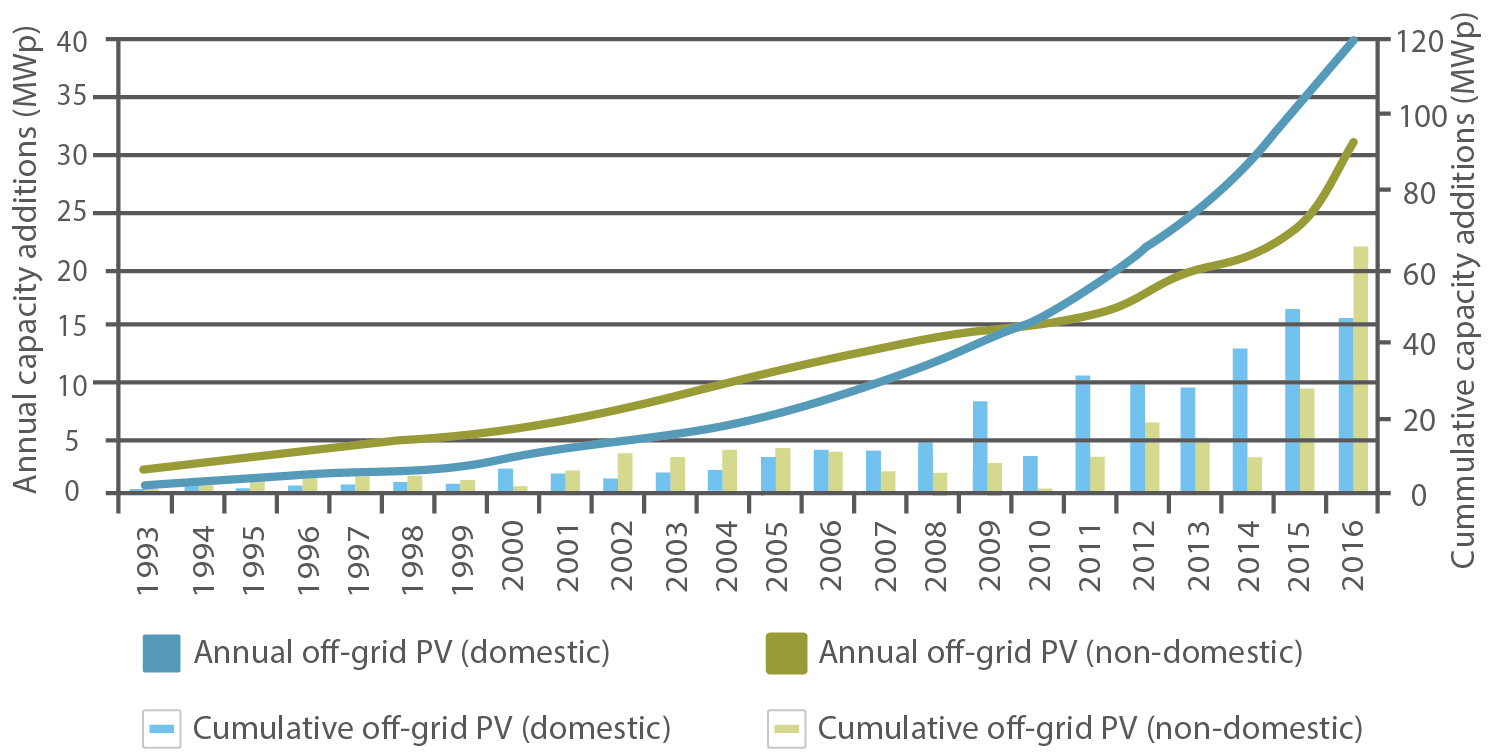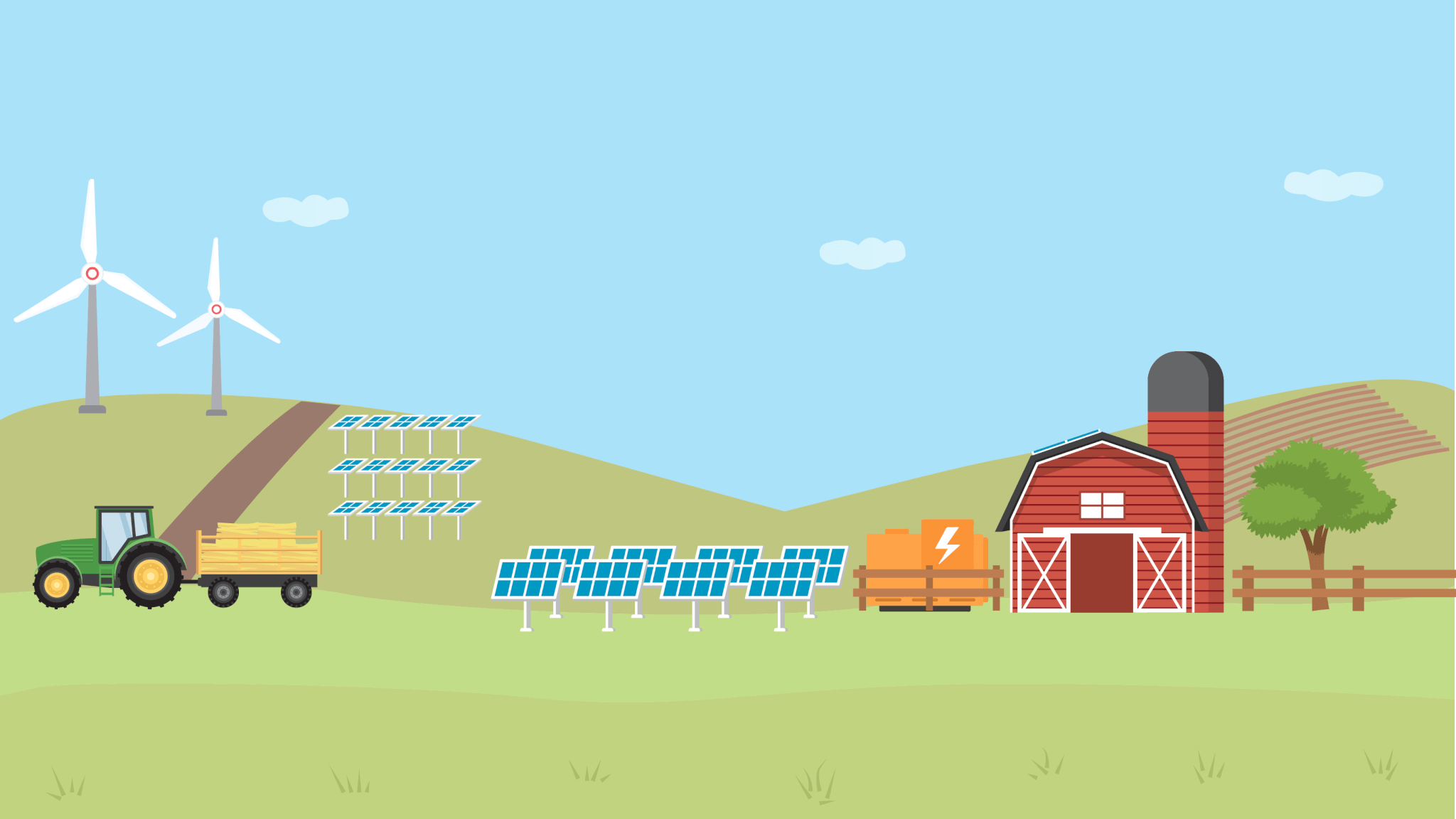Stand-Alone Power Systems (SAPS) have been an alternative and a solution for many decades to power devices, telecommunications, buildings and communities that experience practical or financial barriers to grid electrification, be it in rural areas or in developing countries. SAPS have been used to provide small scale portable lighting, water pumping, and power for general consumption. Nowadays there is growing interest in SAPS in more urbanised areas and in developed nations. The growth of information technologies and an increase in the participation of renewable energy in electricity generation have given rise to the idea that SAPS can be implemented in these regions. Despite a current strong focus on grid-connected renewable energy systems, renewables in stand-alone power is an area of significant growth in Australia, with the amount of PV capacity installed off-grid each year steadily increasing (Figure 1).

Figure 1: Annual and cumulative capacity installed off-grid
Stand-alone power systems are independent electrical networks comprising on-site generators and loads, where the local energy resources are used in order to generate electricity. This is commonly achieved by using solar power and diesel generators but can also include micro-hydro, wind energy, geothermal energy, solar thermal energy and more. The main limitation is the resources that are available in the local area, and what power generation devices can be purchased and installed for a given budget.
In many cases, SAPS in urban areas are not entirely stand-alone and autonomous since the electrical system and loads can be conveniently connected to the grid. But with rising costs of electricity, the concept of having SAPS in urban environments is intriguing because in some cases people have decided to take matters into their own hands and disconnect from the grid, resulting in what is called grid defection. Grid defection occurs when an existing client that is connected to the grid decides to use independent on-site generation rather than grid electricity, with the intention of saving money and also reducing carbon emissions. With renewable energy becoming more affordable and with the advent of domestic storage, this is opening a new market in terms of stand-alone applications.
Not all urban SAPS would be the same as systems installed in remote areas, however micro-hydro, wind power, and geothermal energy can be desirable sources of electricity, but they depend entirely on location. Not all urban environments would necessarily have access to the appropriate resources and individuals may not have legal authority to tap into such supplies. Geothermal energy is a more limited source because the initial costs are higher compared to other sources. However, since solar energy is easily accessible and is now an affordable option, people have been able to successfully power their loads in urban environments. Properly sized PV systems in conjunction with battery storage and a backup generator have enabled households to be able to power their devices without the need of grid electricity. This makes grid defection a much more attractive alternative.
Most instances of grid defection occur at a single residence scale, but there is growing attention to the possibility of having microgrids in locations where a grid connection exists. Microgrids refer to smaller, autonomous, and islanded networks that have on-site generation and multiple points of electrical consumption. Microgrids can be of varying sizes as well. For example, a microgrid can be the size of a city block or a small village and have its on-site generation to power all of the buildings. Having a larger area would allow for more on-site generation capacity, such as larger PV systems, space for larger wind turbines, a secluded location to place the backup generators, co-generation, etc. If the generation is sized appropriately it is possible to have an independent, self-sustaining microgrid.
In the case of a grid defection of a multi-building complex, such as a city block, row of houses or even to the size of an entire suburb, it would be possible that the whole system could effectively operate in islanding mode. This means that the whole complex would be able to disconnect itself from the grid and use its on-site generation to power the buildings. This islanding technique could lead to many applications of varying scale and also open the door to a new market for stand-alone power systems. For remote communities that are far from transmission lines, having a microgrid would be a more affordable solution than being connected to a grid with significant transmission losses and higher costs.
The implications of having microgrids in suburban or urban environments are significant. To the electricity grid operators, this would represent a shedding of load which could be very useful in the case of grid instability or lacking provision of supply during times of high demand. Grid operators could instruct the microgrids to disconnect (or not import) from the grid, allowing buildings to remain powered during periods of high demand or grid outage. Then when the grid stabilizes, the microgrid could then reconnect to the grid. But in the case of unprecedented grid defection, it would also mean a loss of business for the electrical power retail industry.
Stand-alone power systems have a great potential to change the electricity industry if they are designed properly. Grid defection could alter the way that electricity providers, distributors and retailers interact with each other and their customers. It could also bring significant changes to how electricity is traded with the implementation of blockchain technology and peer-to-peer trading. At the same time, the low cost of renewable energy and the reducing price of electricity storage in the form of batteries is making SAPS a more affordable and realistic option for individuals or communities not only located in remote areas, but also in communities who want to have more control over their energy needs.
Global Sustainable Energy Solutions is starting a new Stand Alone Power Systems course in October 2018. The course delivery is online and will also combine practical days at our training centre in Sydney for options with an Install component. Successful completion of the course meets the training requirement for graduates to obtain accreditation with the Clean Energy Council (CEC). The CEC offers three categories of stand-alone power systems accreditation:
- SPS Design Only
- SPS Install Only
- SPS Design and Install
The above are strictly limited to photovoltaic systems. Those who wish to work on micro-hydro and/or small wind power systems must apply for these separately. Due to the continuous advancement of the industry, the CEC have a Continuous Professional Development (CPD) scheme in place to ensure accredited installers and designers obtain 100 CPD points each year as part of their renewable scheme. Not only does this ensure all installers remain up-to-date with best industry practices, it also further develops the solar industry and provides a more reliable structure for the community. Visit our website to learn more: www.gses.com.au
https://www.gses.com.au/wp-content/uploads/2017/06/The-role-of-accreditation-.pdf
https://www.gses.com.au/wp-content/uploads/2016/05/GSES_Standalone-past-present-future.pdf
https://www.solaraccreditation.com.au/installers/apply-for-accreditation.html

